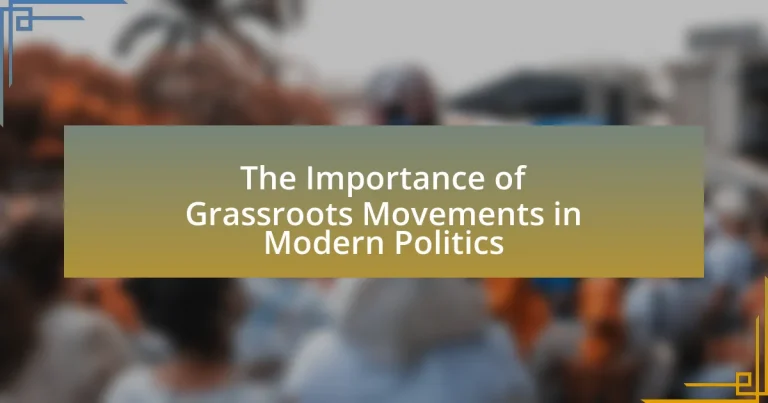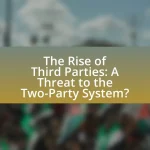Grassroots movements are organized efforts by ordinary individuals aimed at achieving social or political change, emerging primarily from local communities rather than established political institutions. This article examines the significance of grassroots movements in modern politics, highlighting their role in empowering citizens, promoting civic engagement, and influencing policy decisions. It differentiates grassroots movements from traditional political movements, outlines their defining characteristics, and discusses their impact on public policy, voter engagement, and social change. Additionally, the article addresses the challenges these movements face, including funding limitations and opposition from established political entities, while also exploring strategies for enhancing their effectiveness and sustainability.
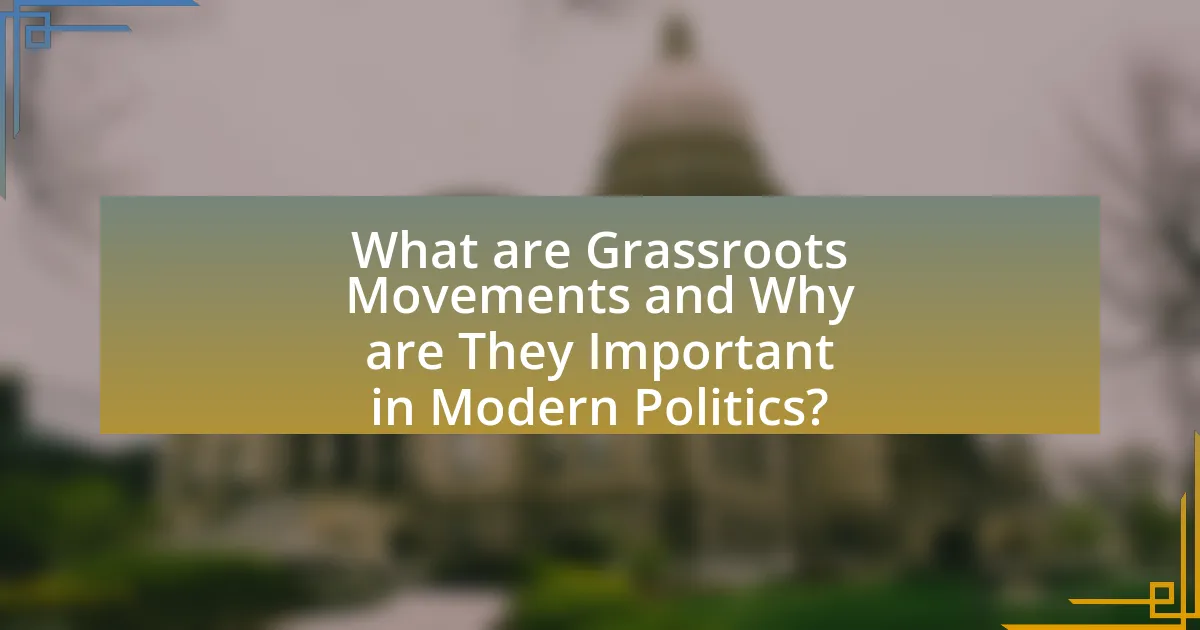
What are Grassroots Movements and Why are They Important in Modern Politics?
Grassroots movements are organized efforts by ordinary people to effect social or political change, often emerging from local communities rather than established political institutions. These movements are important in modern politics because they empower citizens, promote civic engagement, and can influence policy decisions by raising awareness on critical issues. For instance, the Civil Rights Movement in the United States, which began at the grassroots level, led to significant legislative changes such as the Civil Rights Act of 1964. Additionally, grassroots movements often utilize social media to mobilize support and disseminate information rapidly, exemplified by movements like Black Lives Matter, which have gained global attention and prompted discussions on systemic racism and police reform.
How do Grassroots Movements differ from Traditional Political Movements?
Grassroots movements differ from traditional political movements primarily in their structure and approach to mobilization. Grassroots movements are typically initiated and driven by ordinary citizens at the community level, focusing on local issues and relying on collective action, while traditional political movements often involve established political parties or organizations that operate within formal political systems and hierarchies.
For example, grassroots movements like the Civil Rights Movement in the 1960s emerged from community activism and local organizing, contrasting with traditional political movements that may rely on top-down leadership and institutional frameworks. This distinction highlights how grassroots movements prioritize direct participation and community engagement, often leading to more immediate and localized impacts on policy and social change.
What characteristics define a Grassroots Movement?
A grassroots movement is characterized by its community-driven nature, where ordinary individuals mobilize to advocate for social or political change. These movements typically emerge from local communities and rely on the active participation of volunteers rather than established political organizations or leaders. Grassroots movements often prioritize inclusivity, encouraging diverse voices and perspectives to shape their goals and strategies. They utilize direct action, such as protests or community organizing, to raise awareness and influence decision-makers. Historical examples, such as the Civil Rights Movement in the United States, demonstrate how grassroots efforts can lead to significant societal changes, highlighting their effectiveness in modern politics.
Why do Grassroots Movements often emerge in response to specific issues?
Grassroots movements often emerge in response to specific issues because they are driven by the collective concerns and experiences of individuals who feel marginalized or unheard. These movements typically arise when a significant segment of the population identifies a pressing social, political, or environmental problem that requires immediate attention and action. For instance, the Civil Rights Movement in the United States emerged in response to systemic racial discrimination and injustice, mobilizing communities to demand equal rights and social change. This direct response to specific grievances allows grassroots movements to effectively rally support, mobilize resources, and influence public policy, demonstrating their critical role in addressing societal challenges.
What role do Grassroots Movements play in shaping public policy?
Grassroots movements play a crucial role in shaping public policy by mobilizing community members to advocate for specific issues and influence decision-makers. These movements often arise from local concerns and can effectively raise awareness, generate public support, and apply pressure on policymakers. For instance, the Civil Rights Movement in the United States significantly impacted legislation, leading to the Civil Rights Act of 1964 and the Voting Rights Act of 1965, demonstrating how organized grassroots efforts can lead to substantial policy changes. Additionally, grassroots movements utilize social media and community organizing to amplify their messages, making them a powerful force in contemporary political landscapes.
How do Grassroots Movements influence political agendas?
Grassroots movements influence political agendas by mobilizing community members to advocate for specific issues, thereby shaping public discourse and policy priorities. These movements often leverage social media and local organizing to raise awareness and build coalitions, which can lead to significant political pressure on elected officials. For example, the Black Lives Matter movement has successfully brought issues of racial injustice and police reform to the forefront of national politics, resulting in legislative discussions and changes in law enforcement practices across various states. This demonstrates how grassroots activism can directly impact political agendas by transforming societal concerns into actionable policy discussions.
What impact do Grassroots Movements have on voter engagement?
Grassroots movements significantly enhance voter engagement by mobilizing communities and fostering a sense of political efficacy among individuals. These movements often utilize local networks to educate citizens about issues, encouraging participation in elections and civic activities. For instance, the 2018 midterm elections in the United States saw a surge in voter turnout, attributed in part to grassroots organizations like Indivisible and MoveOn, which effectively organized campaigns and outreach efforts. Research indicates that grassroots initiatives can increase voter turnout by as much as 10% in targeted demographics, demonstrating their critical role in energizing the electorate and promoting democratic participation.
Why are Grassroots Movements essential for social change?
Grassroots movements are essential for social change because they empower individuals at the community level to advocate for their rights and influence policy. These movements often arise from the collective efforts of ordinary people who share common concerns, leading to significant societal shifts. For instance, the Civil Rights Movement in the United States, which was largely driven by grassroots activism, resulted in landmark legislation such as the Civil Rights Act of 1964 and the Voting Rights Act of 1965. This demonstrates how grassroots efforts can effectively challenge systemic injustices and bring about legislative change.
How do Grassroots Movements empower marginalized communities?
Grassroots movements empower marginalized communities by providing them with a platform to voice their concerns and advocate for their rights. These movements facilitate collective action, enabling individuals to unite around common issues such as social justice, economic inequality, and political representation. For instance, the Civil Rights Movement in the United States, which was largely grassroots-driven, successfully challenged systemic racism and led to significant legislative changes, including the Civil Rights Act of 1964. This demonstrates how grassroots efforts can mobilize communities, influence public policy, and create lasting social change.
What successes have Grassroots Movements achieved in recent history?
Grassroots movements have achieved significant successes in recent history, notably influencing policy changes and social reforms. For instance, the Black Lives Matter movement has successfully raised awareness and prompted legislative discussions around police reform and racial justice in the United States, leading to the introduction of bills aimed at addressing systemic racism. Additionally, the climate justice movement, particularly through initiatives like the Fridays for Future protests led by youth activists, has successfully pressured governments to commit to more aggressive climate action, resulting in pledges to reduce carbon emissions and invest in renewable energy. These movements demonstrate the power of collective action in shaping public discourse and policy outcomes.
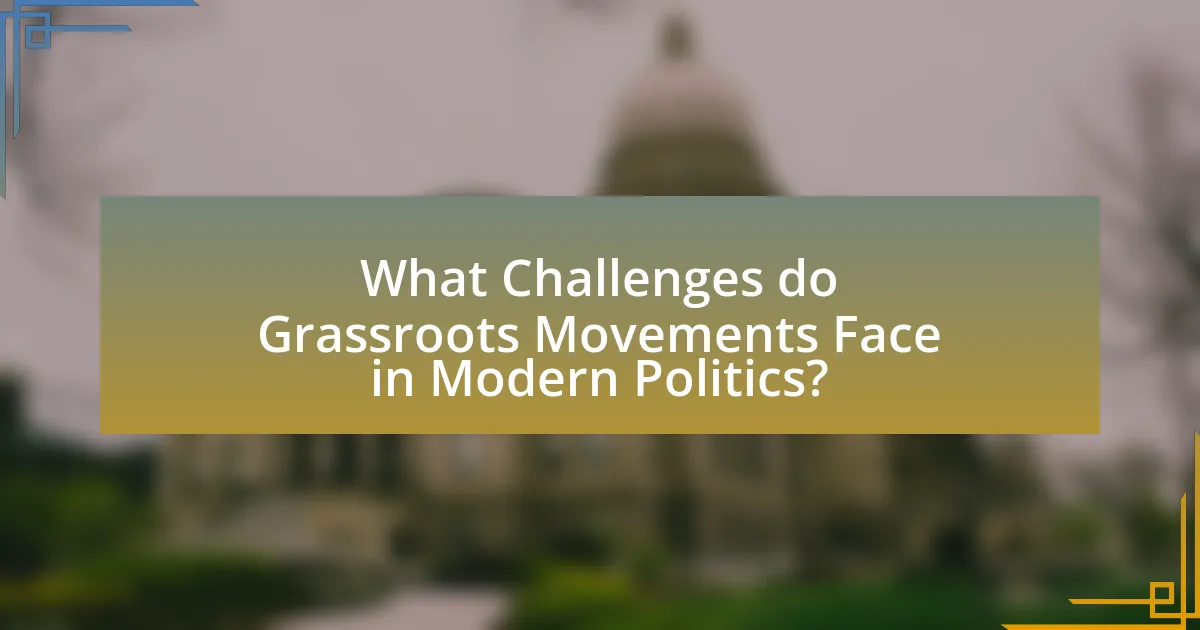
What Challenges do Grassroots Movements Face in Modern Politics?
Grassroots movements face significant challenges in modern politics, including funding limitations, organizational fragmentation, and resistance from established political entities. Funding limitations hinder their ability to sustain campaigns and outreach efforts, as many grassroots movements rely on small donations and volunteer support rather than large financial backers. Organizational fragmentation occurs when diverse groups within a movement struggle to unify their goals and strategies, leading to inefficiencies and diluted impact. Additionally, established political entities often resist grassroots initiatives, employing tactics such as lobbying, misinformation, or legal challenges to undermine their efforts. These challenges are evident in various movements, such as the Occupy Wall Street movement, which faced difficulties in maintaining momentum and cohesion due to these factors.
How do funding and resource limitations affect Grassroots Movements?
Funding and resource limitations significantly hinder grassroots movements by restricting their ability to mobilize, organize, and sustain campaigns. Without adequate financial support, these movements struggle to cover essential costs such as outreach, materials, and event logistics, which are crucial for raising awareness and engaging the community. For instance, a study by the National Democratic Institute found that grassroots organizations with limited funding often fail to reach broader audiences, resulting in diminished impact and effectiveness. Additionally, resource constraints can lead to reliance on a small base of volunteers, which may not be sufficient to maintain momentum or achieve long-term goals. This cycle of underfunding can ultimately stifle the potential for grassroots movements to influence policy and drive social change.
What strategies can Grassroots Movements use to overcome financial barriers?
Grassroots movements can overcome financial barriers by leveraging community fundraising, building partnerships with local businesses, and utilizing digital platforms for crowdfunding. Community fundraising allows movements to engage local supporters who can contribute small amounts, creating a sense of ownership and investment in the cause. Partnerships with local businesses can provide in-kind donations or sponsorships, reducing operational costs while increasing visibility. Digital platforms for crowdfunding, such as GoFundMe or Kickstarter, enable movements to reach a wider audience, facilitating contributions from individuals who resonate with their mission. For example, the Black Lives Matter movement successfully utilized social media to mobilize financial support, raising millions through online donations during pivotal moments in their advocacy.
How does access to technology impact the effectiveness of Grassroots Movements?
Access to technology significantly enhances the effectiveness of grassroots movements by facilitating communication, organization, and mobilization. Technology enables grassroots activists to reach a wider audience quickly through social media platforms, which can amplify their messages and increase public engagement. For instance, the Arab Spring demonstrated how social media was instrumental in organizing protests and disseminating information rapidly, leading to substantial political changes in several countries. Furthermore, data from the Pew Research Center indicates that 69% of Americans use social media, providing grassroots movements with a powerful tool to connect with supporters and coordinate actions efficiently. This access to technology not only streamlines logistical efforts but also fosters a sense of community among participants, ultimately increasing the likelihood of achieving their objectives.
What opposition do Grassroots Movements encounter from established political entities?
Grassroots movements encounter significant opposition from established political entities, primarily through institutional resistance, resource allocation, and political co-optation. Established political entities often view grassroots movements as threats to their power and influence, leading to efforts to undermine their legitimacy and suppress their activities. For example, political parties may use legal mechanisms to restrict protests or limit funding for grassroots initiatives, as seen in various countries where laws have been enacted to control public demonstrations. Additionally, established entities may attempt to co-opt grassroots movements by adopting their language or goals to dilute their impact, as evidenced by the incorporation of social justice rhetoric by mainstream parties without substantive policy changes. This dynamic illustrates the challenges grassroots movements face in navigating a political landscape dominated by established interests.
How do traditional political parties respond to Grassroots Movements?
Traditional political parties often respond to grassroots movements by either co-opting their agendas or opposing them. When grassroots movements gain significant public support, parties may adopt similar policies to attract those voters, as seen with the Democratic Party’s incorporation of progressive ideas from movements like Occupy Wall Street. Conversely, parties may also resist grassroots movements, viewing them as threats to their established power, which can lead to attempts to undermine or discredit these movements, as evidenced by the backlash against the Tea Party by mainstream Republicans. This dual approach reflects the parties’ need to balance their traditional bases with emerging public sentiments.
What tactics do Grassroots Movements employ to counteract opposition?
Grassroots movements employ tactics such as community organizing, coalition building, and strategic communication to counteract opposition. Community organizing involves mobilizing local individuals to advocate for shared goals, which strengthens their collective voice against opposing forces. Coalition building allows grassroots movements to unite with other organizations, amplifying their impact and resources, as seen in the collaboration between various civil rights groups during the 1960s. Strategic communication focuses on effectively disseminating their message through social media and traditional media channels, enabling them to shape public perception and counter misinformation. These tactics have proven effective in various historical contexts, such as the anti-apartheid movement in South Africa, where grassroots efforts played a crucial role in dismantling systemic oppression.
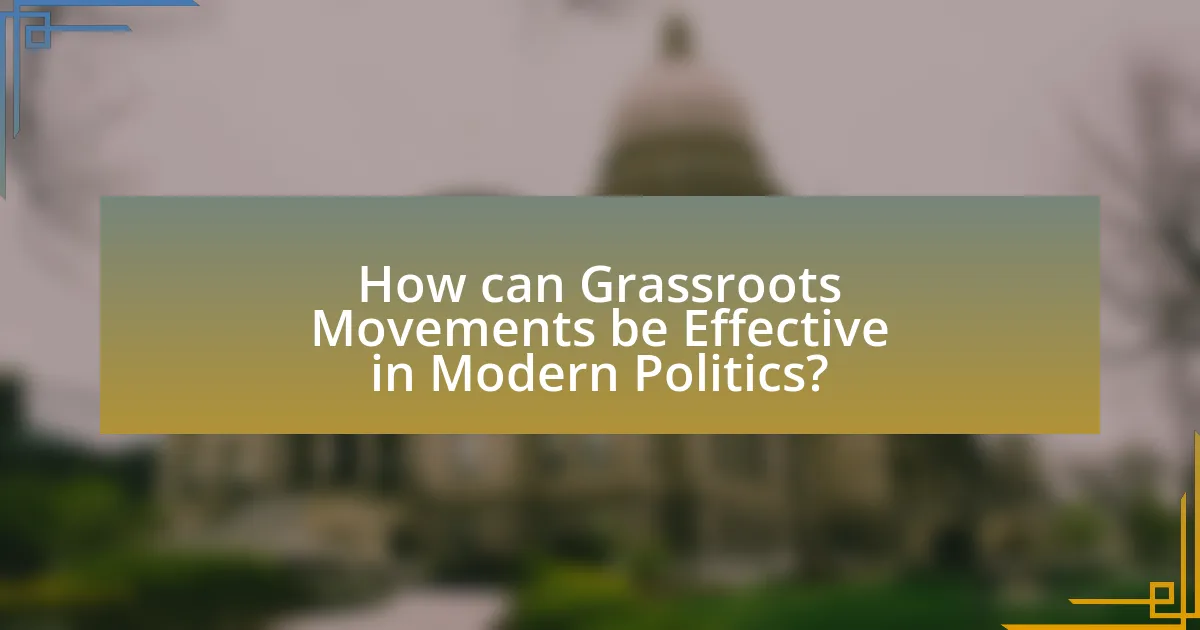
How can Grassroots Movements be Effective in Modern Politics?
Grassroots movements can be effective in modern politics by mobilizing community members to advocate for change, influencing policy decisions, and raising awareness on critical issues. These movements often leverage social media platforms to organize, communicate, and amplify their messages, reaching a broader audience quickly. For instance, the Black Lives Matter movement utilized social media to mobilize protests and influence public discourse on racial justice, leading to significant policy discussions and reforms in various jurisdictions. Additionally, grassroots movements can create a sense of community and shared purpose, empowering individuals to participate actively in the political process, which can lead to increased voter turnout and engagement in local governance.
What strategies enhance the effectiveness of Grassroots Movements?
Effective grassroots movements utilize strategies such as community engagement, coalition building, and leveraging social media. Community engagement fosters local support and mobilizes individuals around shared goals, as seen in the Civil Rights Movement, where grassroots organizing was crucial for mobilizing public opinion and action. Coalition building enhances effectiveness by uniting diverse groups with common interests, exemplified by the Women’s March, which brought together various organizations to amplify their collective voice. Leveraging social media allows for rapid information dissemination and mobilization, demonstrated by the success of the #MeToo movement in raising awareness and encouraging participation on a global scale. These strategies collectively enhance the reach and impact of grassroots movements in modern politics.
How can Grassroots Movements leverage social media for mobilization?
Grassroots movements can leverage social media for mobilization by utilizing platforms to disseminate information rapidly, engage supporters, and organize events. Social media allows these movements to reach a broader audience, facilitating the sharing of messages and calls to action that can lead to increased participation. For instance, the Black Lives Matter movement effectively used Twitter and Facebook to mobilize protests and raise awareness about racial injustice, demonstrating the power of social media in rallying support and driving collective action. Additionally, studies show that social media campaigns can significantly enhance grassroots fundraising efforts, enabling movements to gather resources quickly and efficiently.
What role does community organizing play in the success of Grassroots Movements?
Community organizing is essential for the success of grassroots movements as it mobilizes individuals around shared goals, fostering collective action. This process builds relationships among community members, enhances communication, and empowers participants to advocate for their interests effectively. Historical examples, such as the Civil Rights Movement, demonstrate that organized communities can challenge systemic injustices and achieve significant policy changes. Research indicates that grassroots movements with strong community organizing efforts are more likely to sustain momentum and influence political outcomes, as seen in the success of initiatives like the Fight for $15 campaign, which effectively organized workers to demand higher wages.
What best practices should Grassroots Movements adopt for sustainability?
Grassroots movements should adopt community engagement, resource management, and coalition-building as best practices for sustainability. Community engagement fosters local support and participation, which is crucial for long-term viability; for instance, movements that actively involve community members in decision-making processes tend to have higher retention rates and impact. Effective resource management ensures that financial and human resources are utilized efficiently, allowing movements to operate sustainably over time; studies show that organizations with clear budgeting and resource allocation strategies are more likely to achieve their goals. Coalition-building with other organizations amplifies voices and resources, creating a stronger collective impact; historical examples, such as the Civil Rights Movement, demonstrate that alliances can significantly enhance the reach and effectiveness of grassroots initiatives.
How can Grassroots Movements build coalitions with other organizations?
Grassroots movements can build coalitions with other organizations by identifying shared goals and values, which fosters collaboration. By engaging in open dialogue and establishing mutual trust, grassroots movements can align their objectives with those of other organizations, creating a unified front. For instance, the Civil Rights Movement in the 1960s successfully formed coalitions with labor unions and religious groups, amplifying their impact and reach. This historical example illustrates that when grassroots movements actively seek partnerships based on common interests, they can leverage collective resources and networks to achieve greater political influence and social change.
What methods can Grassroots Movements use to maintain momentum over time?
Grassroots movements can maintain momentum over time by employing consistent communication strategies, building strong community networks, and leveraging social media platforms. Consistent communication keeps supporters informed and engaged, fostering a sense of belonging and urgency. Strong community networks create a support system that encourages participation and collaboration, as seen in movements like Black Lives Matter, which effectively mobilized local chapters to sustain activism. Additionally, leveraging social media allows for rapid dissemination of information and mobilization of supporters, as demonstrated by the success of the Ice Bucket Challenge in raising awareness and funds for ALS research. These methods collectively ensure that grassroots movements remain active and influential in the political landscape.
What practical steps can individuals take to support Grassroots Movements?
Individuals can support grassroots movements by actively participating in local initiatives, volunteering time, and donating resources. Engaging in community events, attending meetings, and spreading awareness through social media amplifies the movement’s message. Research indicates that grassroots campaigns often rely on local support to gain traction; for instance, the 2018 midterm elections saw a significant increase in voter turnout driven by grassroots efforts, highlighting the effectiveness of community involvement. By contributing to these movements, individuals help foster democratic engagement and social change.
How can community members get involved in local Grassroots Movements?
Community members can get involved in local grassroots movements by participating in organizing efforts, attending meetings, and volunteering for campaigns. Engaging in these activities allows individuals to contribute their skills and resources to support causes they care about. For instance, according to a study by the National Civic League, grassroots movements often rely on community participation to mobilize support and create change, demonstrating that active involvement can lead to significant political and social impact.
What resources are available for those looking to start a Grassroots Movement?
To start a grassroots movement, individuals can access various resources including online platforms, community organizations, and educational materials. Online platforms such as social media networks (Facebook, Twitter) facilitate outreach and mobilization, allowing organizers to connect with supporters and disseminate information quickly. Community organizations often provide support through training, funding, and networking opportunities, which are essential for building a strong foundation. Educational materials, including books and guides on activism and organizing, offer strategies and insights into effective grassroots campaigning. For instance, “Grassroots Rules: How the Community Can Help You Win” by David K. Johnson provides practical advice on mobilizing community support. These resources collectively empower individuals to effectively initiate and sustain grassroots movements.
